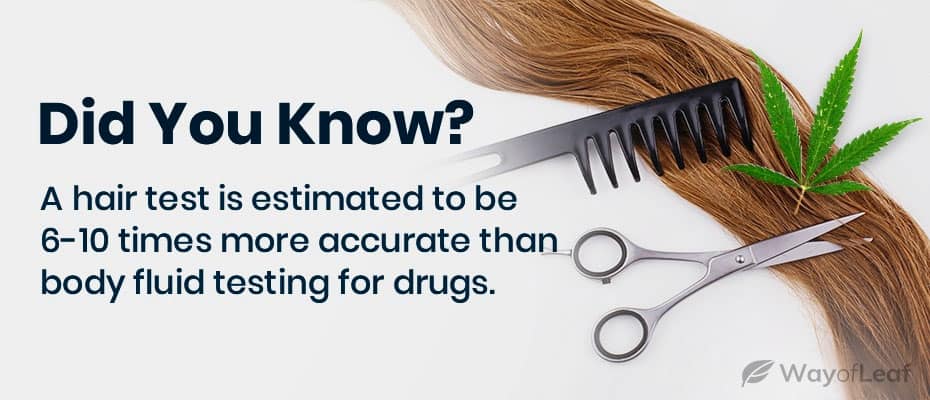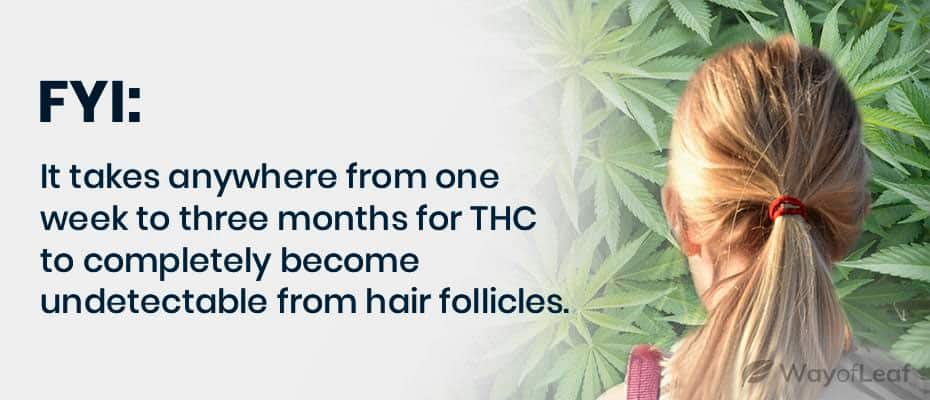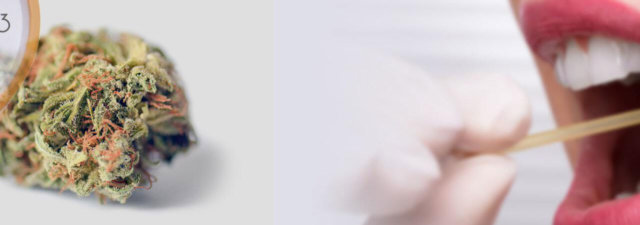A hair follicle drug test is among the fastest-growing drug screening methods in the U.S. It is considered more accurate than both mouth swabs and urine tests, which remain popular forms of testing. THC metabolites can take about five days to show up in your hair. However, a hair follicle test can continue to detect THC for several months.
In general, a hair follicle drug test is designed to catch regular marijuana users. Therefore, it is extremely difficult to pass a screening if you habitually consume the substance. Given that employers in many states can still legally terminate the contracts of employees who fail drug tests, the stakes are extremely high.
This article takes a detailed look into hair follicle drug tests. It outlines how the test works, its accuracy, and potential ways of passing it, including common tactics that DO NOT work.
How Do THC Metabolites Get in Your Hair?
There are two primary ways marijuana can end up in your hair.
A hair follicle test screens for the presence of THC-COOH. This is a metabolite formed during the breakdown of THC. It forms when the THC in your blood passes through the liver and is stored in the fatty tissue around your body. This includes body fat deposits and organs such as your lungs, kidneys, and heart.

Additionally, THC-COOH ends up in your hair by traveling through your sebaceous gland. This gland secretes natural oils (also known as sebum) on the skin and scalp. The THC-COOH is then secreted in your body’s natural oils along with sweat, which is what coats the strains of hair.
Secondly, THC and other compounds associated with cannabis can appear on the hair of non-consumers. By interacting with the cannabis plant or with people who have consumed cannabis, the cannabinoids can be transferred to the non-user’s hair. Cannabinoids can be transferred via either sebum, smoke, sweat, or even hand-to-hand contact.
How Long Does Weed Stay in Your Hair Follicles?
THC metabolites remain in the hair for up to 90 days on average. Therefore, abstinence alone won’t help you pass an upcoming drug screening. Testers use samples from close to the scalp. The clipping is usually 1.5 inches long (100-120 strands of hair), representing about 90 days of hair growth because hair grows at approximately 0.5 inches per month.
It’s worth mentioning that 90-days is by no means an exact number, though. Hair growth differs from person to person, so 90 days for one person could be 110 days for someone else.
Yet another factor that plays a part in hair growth is age. The older you are, the slower your hair growth rate.
Ultimately, cannabinoids, such as THC-COOH, will stay in your hair strands until your hair is either cut off or falls out.
How Does a Hair Follicle Test Work?
When you ingest marijuana, it circulates through the bloodstream and into your urine, saliva, blood, and hair follicles via the bloodstream. The drug metabolites that enter your hair follicles become trapped in the hair structure as it starts to grow out. Drug testing labs will typically test for toxic metabolites trapped in the shaft core. Also, they test for THC in strands of hair rather than the follicle itself.
The length of your hair sample can measure historical drug use, but it’s not possible to determine a specific timeline of usage. A hair follicle test cannot determine the difference between THC metabolites introduced two weeks ago and ones introduced two days ago.

Before the body rapidly breaks down the cannabinoids in the blood, the compounds bind to the sheath of tissue and cells surrounding the root of your hair. This initially happens beneath the surface of your scalp. However, eventually, the cannabinoids become incorporated into the follicle and ultimately the hair strand itself.
Finally, after about five to ten days, the “weed-infused hair” gets to the top of your head. This is why it’s not easy to cheat a hair follicle drug test.
For the record, the cutoff point for marijuana metabolites in a hair follicle test is one picogram per milligram (1pg/mg). The confirmatory test (usually GS/MS) is 0.1 pg/mg. A picogram is equivalent to one trillionth of a gram.
A negative test is generally confirmed within 24 hours, with most companies using a test called ELISA. A positive result is generally confirmed within 72 hours. In this instance, your hair receives a gas chromatography/mass spectrometry test (GC/MS). If it confirms the initial positive test, you can expect repercussions.
Why Do Companies Use a Hair Follicle Drug Test?
While a hair follicle test isn’t as popular as a urinalysis, employers are coming round to the idea of using it. Here are a few reasons why:
- Hair is less susceptible to tampering, adulteration, and substitution than urine samples.
- The applicant can’t eat or drink anything that will dilute a hair sample.
- Generally speaking, shaving or dying the hair will not help regular marijuana users. Most labs test for a relatively low amount of THC, so stripping the hair won’t remove enough of the substance.
The marijuana hair test is simpler and less intrusive than urine testing. The institution conducting the test should consider the following:
- They should always have enough hair to repeat the test if necessary.
- If the hair is over 1.5 inches long, the sample must be 0.5 inches wide when spread out flat on a ruler.
- If the hair is shorter than 1.5 inches in length, the tester requires a different width in the sample. For instance, hair that’s an inch long should be 0.75 inches, while hair that’s 0.5 inches long should be 1.5 inches wide. The test requirements are weight-specific; 100mg of hair.
A tester can collect hair follicle test samples from several locations on the head and body to get the necessary sample. Generally, they take the hair from the crown of the head, but if your hair is too short, they can use body hair. Body hair is even worse than head hair in terms of detection, as it represents a time frame of approximately one year. The growth pattern in the hair and below the neck can differ significantly.
How to Pass a Hair Follicle Drug Test
It is incredibly difficult to pass the screening if you’re a regular marijuana user and suddenly get called in for testing. It is different if you’re an infrequent user who recently used the substance. After all, the hair follicle test only detects cannabis use in the last 5-10 days. Also, the detection rate is lower if you’ve only used the drug a couple of times in the last three months.
Although the hair follicle drug test is relatively sensitive, only regular weed users that ingest lots of THC should be concerned about triggering a positive result.
Passing a hair follicle test is all in the timing. If you are aware of an upcoming drug test, you should abstain from marijuana usage immediately.
Ultimately, passing a hair drug test is all in the timing. If you are aware of an upcoming drug test, you should abstain from marijuana usage immediately. It’s also essential to avoid all skin-to-skin contact with anybody who consumes cannabis. There is always the risk that this type of contact could transfer weed metabolites onto the hair follicles.
Detox shampoos offer hope to those who face the prospect of a hair follicle test. The following are among the most popular products:
- Zydot Ultra-Clean
- Neutrogena T/Sal
- Old Style Aloe Toxin Rid
The Zydot offering contains packets of specially formulated conditioners and purifiers. The T/Sal includes salicylic acid, which should help remove all dirt and grease buildup in your hair. Lastly, the Aloe Toxin Rid performs the detoxifying functions that should eliminate pollutants, medicines, and other stressors from the hair.
If you have time to spare, there is a way to pass a hair follicle test in 10 days using one or more of the above shampoos.
The Jerry G Method
The first step involves using a hair dye that contains ammonia. Then you need to use a detox shampoo to cleanse the hair. On the day before the test, you have to use the hair dye again. On screening day, apply baking soda all over the hair to form a thick paste. Then, you have to wash and rinse your hair before finally using one of the above detox shampoos again.
Is There Any Way to Pass a Hair Follicle Test in 2 Days?
The nature of drug testing means that screening will come as a surprise, meaning the Jerry G method is unhelpful. However, proponents claim one popular last-ditch option has a high success rate.

The Macujo Method
The Macujo method supposedly opens the cuticles and cortex, removing all traces of THC in the hair by exposing it to acid. It will cause short-term damage to the hair, but you may feel it is worth the risk if the alternative is losing your job. Here is a list of the equipment you need:
- Vinegar with a high percentage of acetic acid
- A shampoo containing salicylic acid
- A detox or aloe-based shampoo
- Disposable rubber gloves
- Shower caps
- Goggles
- Warm water
Once you have assembled the above, follow these steps:
- Rinse your hair with warm water to remove oil in the hair and open up your cuticle.
- Add vinegar to open the hair shaft and clean out toxins in the body.
- Add the salicylic shampoo to your hair and leave it in for a few minutes. Cover your hair with a shower cap.
- Rinse your hair thoroughly after 30 minutes, and apply the detox shampoo.
- Go through the above at least four more times to remove THC-COOH metabolites. Some people add tide detergent to the mix when repeating the process to boost their chances of success.
Although the Macujo method could help you pass the test, it may cause an allergic reaction if you have sensitive skin. Additionally, you should spend a lot of time re-nourishing, hydrating, and conditioning your hair after your detox routine.
You could consider using a hairpiece or hair extension in a last-ditch effort to pass a hair test for drugs. There is, however, no guarantee that the tester wouldn’t get a piece of your actual hair.
What Else Can a Hair Drug Test Detect?
Companies don’t just use a hair follicle test to detect marijuana consumption. It can also screen for the following drugs:
- Cocaine
- Heroin
- Codeine
- Morphine
- MDMA
- Methamphetamine
- PCP
Your hair will likely contain traces of any of the above for at least three months after your last use.
Tricks That Won’t Help You Pass a Hair Follicle Drug Test
As we have already determined, a hair follicle test is difficult to cheat, but people try all sorts of desperate tactics. Many of these attempts are well documented, and most are destined to fail, like the following.
Shaving the Head
First of all, it looks extremely suspicious if you suddenly show up at a test with a freshly shaved head. Secondly, the tester will take hair from another part of the body, increasing the likelihood of a failed test.
Bleaching or Dying the Hair
Dying or bleaching your hair may seem like a good idea, but it isn’t useful in reality. Quest Diagnostics, one of the country’s largest drug testing and diagnostics companies, found that hair treatments have minimal effect on the hair follicle test results.
Are Hair Follicle Tests Accurate?
Yes, but they are not 100% accurate. One of the more noteworthy studies, conducted by German researchers in 2015, investigated the reliability of these tests. The research group completed two studies. The first involved one person using THCA-A, while the second investigated what happened when two participants used THC.
The volunteer consumed 50mg of THCA-A daily for 30 days in study one. The researchers tested the person at the end of the study and didn’t detect THCA-A in hair, sebum, or sweat samples.
Researchers have detected the THC metabolite THC-COOH in beard hair samples up to 11 weeks after the last intake of THC.
In study two, the volunteers consumed 2.5 milligrams of dronabinol (a synthetic form of THC) three times per day for 30 days. The researchers tested the volunteers and detected no THC in head, beard, or body hair.
However, Participant #2 showed THC-COOH positive results in a hair segment collected six weeks after the first intake. Also, the researchers detected THC-COOH in beard hair samples up to 11 weeks after the last intake of THC.
They also detected THC-COOH in segments correlating to a period between 2.3 and 3.1 months before the beginning of the study. Additionally, they found that long hair resulted in more significant contamination. The study suggested that THC found in the hair must come from various sources (i.e., second-hand smoke) rather than just circulation through the bloodstream.
Additional Research
A study published in Drug and Alcohol Dependency in 2017 also looked into hair follicle testing for detecting THC. The researchers collected hair samples from 136 volunteers who were heavy, light, or non-users of marijuana. Next, they performed testing using GC-MS/MS and looked for the following:
- THC
- THC-OH
- THC-COOH
- CBN
- CBD
Overall, 77% of heavy users tested positive for THC, compared to 39% of light users and 0% of non-users. The researchers concluded that hair follicle testing could be a qualitative indicator of heavy marijuana consumption within the previous three months. However, it was unreliable when trying to detect light marijuana use. They also wrote that this form of testing is unreliable when ascertaining the quantity of cannabis used.
Final Thoughts on Hair Follicle Drug Tests
Most marijuana users search for a quick fix to get through the dreaded drug test. However, unfortunately, when it comes to the hair follicle test, there’s very little you can do to beat it. The main ways of passing the test involve detoxifying the hair with Old Style Aloe Toxin Rid Shampoo or using the Macujo method.
On the plus side, hair follicle tests are not 100% accurate. In theory, someone could fail because they were in contact with a marijuana user or the plant itself. However, you will find it hard to convince an employer that this is the case if you fail the test.
Therefore, at present, the best way to pass a hair follicle test is to avoid the consumption of illicit substances completely.
If you are looking for a detox product, we’ve tested quite a few different products. Below are the results from products we tried out.
FAQs
What Is a Hair Follicle Test’s Detection Window?
As a general rule of thumb, a hair follicle test can detect THC-COOH metabolites up to 90 days after your last use. This is because testers tend to take 1.5 inches of hair, and hair grows at a rate of around 0.5 inches per month. However, the above is only a ballpark figure and could be higher or lower depending on various factors.
Can a Hair Follicle Test Detect One-Time Use?
The test is unlikely to detect marijuana in infrequent users. For example, if you consumed the substance 2-3 times in the last 90 days, it is very unlikely that you’ll fail a hair follicle test. Moreover, it won’t detect THC if you recently used weed because it takes 5-10 days for THC to bind to the hair and grow out of the scalp.
How to Read Hair Follicle Test Result Levels
You are deemed to fail a hair follicle test if the reading is at or above 1pg/mg. In this case, a confirmatory gas chromatography/mass spectrometry (GC/MS) test is performed. A reading of 0.1 pg/mg is considered a fail.
Will Bleaching Your Hair Pass a Hair Follicle Test?
The process of bleaching your hair is highly unlikely to help you pass the drug screening. Instead, you need to invest in special detox shampoos and perform the Macujo method. However, there is no guaranteed method of passing a hair follicle test barring avoiding illegal substances entirely.
How Do Drug Toxins Get into Your Hair?
Drug toxins get into the hair via the bloodstream. The body metabolizes the cannabinoids in our blood, but cannabinoids bind to the sheath of cells and tissue surrounding the hair’s root before this. The process happens beneath the scalp’s surface, but soon, the toxins become incorporated into the follicle and eventually strands of hair. After a few days, the THC-infused hair comes out of your scalp.


![What Is Powdered Urine? [Does It Really Work?]](https://wayofleaf.com/wp-content/uploads/2019/06/wol_what-is-powdered-urine-640x225.jpg)



![Failed a Drug Test After Taking CBD Oil? [Here’s Why…]](https://wayofleaf.com/wp-content/uploads/2019/06/mj_cbd-oil-on-drug-tests-640x225.jpg)


![How to Pass a Drug Test Today [5 Hacks]](https://wayofleaf.com/wp-content/uploads/2019/08/wol-banner-how-to-pass-a-drug-test-640x225.jpg)
